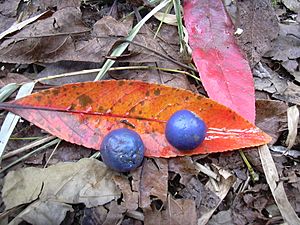Elaeocarpus angustifolius facts for kids
Quick facts for kids Elaeocarpus angustifolius |
|
|---|---|
 |
|
| Leaves and fruit on the ground in Keʻanae Arboretum | |
| Scientific classification | |
| Genus: |
Elaeocarpus
|
| Species: |
angustifolius
|
The Elaeocarpus angustifolius is a type of flowering plant. It belongs to the Elaeocarpaceae family. This tree grows in many places, from India to New Caledonia and northern Australia.
It is a large tree, often with big buttress roots. Its leaves have wavy edges. The flowers are creamy white. The fruit is usually round and bright blue or purple. Scientists have different ideas about exactly where this tree grows.
Contents
About the Blue Quandong Tree
Elaeocarpus angustifolius is a tall tree. It can grow up to 40 meters (about 130 feet) high. It often has wide, strong roots at the bottom of its trunk. These are called buttress roots.
The leaves are about 60 to 180 mm (2.4 to 7.1 inches) long. They are 40 to 60 mm (1.6 to 2.4 inches) wide. Their edges have a wavy, saw-like pattern. Old leaves often turn bright red before they fall off.
The flowers grow in long clusters up to 100 mm (3.9 inches) long. Each flower hangs on a small stalk. The flowers are creamy white. They have five petals, each about 12 to 15 mm (0.47 to 0.59 inches) long. The petals have thin, finger-like tips.
The tree has many stamens, which are the parts that make pollen. The fruit is round and bright blue or purple. It is about 15 to 23 mm (0.59 to 0.91 inches) across. This type of fruit is called a drupe.
How it Got its Name
The Elaeocarpus angustifolius was first officially described in 1825. A scientist named Carl Ludwig Blume wrote about it. He found the plant in the mountains near Batavia (now Jakarta, Indonesia). He included his description in his book, Bijdragen tot de Flora van Nederlandsch Indie.
Where the Tree Grows
Scientists have different ideas about where Elaeocarpus angustifolius grows. Some sources say it grows from the Himalayas to China and the southwest Pacific. They do not include Australia or New Guinea.
However, some Australian experts say it grows in the Northern Territory. They have found it on the Tiwi Islands. It also grows from Channel Point to Wadeye. In these areas, it can reach about 25 meters (82 feet) tall. The government of Queensland also believes this tree grows in their state.
How it Spreads
Some Elaeocarpus angustifolius trees were planted in Oahu, Hawaii, in the 1930s. Since then, they have started to grow naturally in nearby forests. This means they have become naturalized. The tree is also known to spread into forests in Samoa.
What it is Used For
Gardening
The blue quandong tree has very wide-ranging buttress roots. It also grows to be very large. Because of this, it is not a good choice for small home gardens. It should not be planted near drains either. This tree is better suited for larger properties or rainforest parks.
Timber
The wood from this tree is highly valued. It is also important for helping rainforests grow back.
Gallery
Images for kids
See also
 In Spanish: Quandong Azul para niños
In Spanish: Quandong Azul para niños












